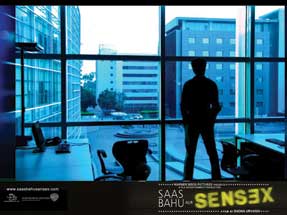Arts
Hollywood's Bollywood Tango

Hollywood heads east to strike Bollywood gold.
India’s rickshaw drivers and tech tycoons may live worlds apart, but spend Saturday nights similarly – at the movies. Bollywood, as the dominant Mumbai-based film industry is dubbed, churns out nearly 1,000 films every year, double that of Hollywood, for India’s movie-mad public.
Across the world, American films reign supreme. In India, however, local productions, with their unique song and dance sequences, dominate 95% of the nation’s movie market. Yet Mumbai has long been home to foreign studios. Hollywood routinely dubs its blockbusters into regional languages. Spiderman III, for example, broke records last spring with one of the most successful foreign film debuts in India. American studios also acquire rights and distribute Indian films abroad, like Sony’s acquisition of Meerabai. This fall, Warner Bros. and Disney are debuting three locally produced feature films, while Fox and Viacom are working on future productions. Even staid Wall Street launched mutual funds investing in India’s bullish entertainment industry. Numbers explain why: PricewaterhouseCoopers expects the Indian film industry will grow 14% to $2.6 billion in 2008. By contrast, Exhibitor Relations expects that American film attendance will continue its four-year decline – already down 2% year to date.
Yet the experience of Sony, Hollywood’s first studio to produce a Hindi film with last November’s Sawaariya, is a cautionary tale. Buzzworthy billboards and previews prompted Sawaariya’s record-breaking debut on India’s important Diwali holiday, but it faltered quickly against competitor Om Shanti Om. Deborah Schindler, president of Sony’s International Division, maintains Sawaariya was a success for the studio (the film cost $8 million and earned $16 million at the box office). Critics labeled Sawaariaya’s perceived failure a cultural mismatch – a dark Dostoevsky-based plot ill suited for India’s joyous holiday season. But film critic Anupama Chopra puts the blame on media bias: “Bollywood royalty and Om Shanti Om star Sharukh Khan invoked national pride and smartly cast Sawaariya as Hollywood’s Goliath attacking his local film and the press promoted that battle,” Chopra says. In retrospect, Schindler, too, acknowledges that Sony underestimated India’s influential press.
Hollywood is undeterred, as international revenues are more important than ever for studios’ bottom lines. In September, Warner Bros. released Sass Bahu Aur Sensex, which targets India’s affluent young elite in an urban comedy set against the booming stock market. The film, which is directed by a young female director Shona Urvashi, sought to lure India’s youth against the backdrop of the country’s optimistic economic boom. In January, Warner Bros. will be releasing Chandani Chowk to China, starring Bollywood heavyweight Akshay Kumar, as a lowly Mumbai cook mistaken for a martial arts master, and model actress Deepika Padukone. Richard Fox, head of Warner Bros. International, describes the film as a “traditional big budget, big star, great dance number” film consciously crafted like Om Shanti Om, but with a twist: this will be the first Hindi-language film shot in China. The film’s $10 million budget, which is large by Indian standards, “respectfully appeals to the core Hindi audience,” Fox says.
Other studios are consciously gambling with different formats. Yash Raj Films debuted Roadside Romeo, India’s first full-length animated feature, on Diwali. This new movie medium, however, follows a familiar Bollywood format. Roadside Romeo features the voice of box office draw Kareena Kapoor. Lead canine characters still break out into song and dance. According to Yash Raj Films President Sanjeev Kohli, “the collaborative goal is to create a true Hindi film in plot, music, cast, marketing, and distribution but with animated characters.” And while Kohli and Disney are determined to pioneer India’s animation field, competing studios are close behind. In June, Warner Bros. announced work on its first animated feature with India’s Goel Screencraft productions. One crucial factor in Hollywood’s success in Bollywood depends on the strength of its local partners. Sony’s Deborah Schindler tapped legendary director Sanjay Leela Bhansali for Sawaariya. Warner Bros.’ Fox believes that the studio’s work with noted director Ramesh Sippy will be integral to the partnership’s overall success. “We are not entering the industry with a motivation to change it, but rather work within it to create quality productions,” Fox says.
Chopra believes Hollywood’s move east benefits Bollywood. “Many great Indian films lack distribution necessary for worldwide viewing and Hollywood helps that,” she says. That’s where Hollywood comes in. “We are a small Indian player but large worldwide and can leverage global networks for these movies,” Fox says. If their debuts stumble? “Creating movies in India is a marathon, not sprint,” he says, “and industry success demands long-term commitment.”
|







